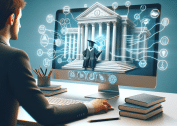The landscape of education is undergoing a profound transformation, driven by rapid advancements in technology. As we navigate through 2025, several key trends are reshaping how educators teach and students learn. These innovations aim to enhance engagement, personalize learning experiences, and prepare learners for a dynamic future.

1. Artificial Intelligence: Personalizing Learning at Scale
Artificial Intelligence (AI) continues to revolutionize education by providing personalized learning experiences. Platforms like Squirrel AI and Microsoft’s Reading Coach analyze students’ strengths, weaknesses, and learning styles to tailor content accordingly . This approach not only caters to individual needs but also helps in identifying areas requiring intervention, ensuring that no student is left behind.
Moreover, AI is streamlining administrative tasks such as grading and lesson planning, allowing educators to focus more on interactive and meaningful student interactions .
2. Immersive Learning: Engaging Through AR and VR
Augmented Reality (AR) and Virtual Reality (VR) are transforming traditional classrooms into immersive learning environments. These technologies enable students to explore complex concepts in a hands-on manner, from virtual field trips to interactive science experiments .
The integration of AR and VR not only enhances engagement but also improves knowledge retention by providing experiential learning opportunities .
3. Data Analytics: Informing Instructional Strategies
The collection and analysis of educational data, known as “datafication,” are playing a pivotal role in shaping instructional strategies. Learning analytics tools assess student performance, engagement, and learning patterns, offering insights that help educators tailor their teaching methods .
This data-driven approach facilitates personalized learning, enabling educators to provide targeted support and interventions based on individual student needs.
4. Microlearning: Delivering Bite-Sized Content
Microlearning involves delivering content in small, focused segments, making it easier for students to absorb and retain information. This approach is particularly effective in today’s fast-paced learning environments, where attention spans are shorter. Microlearning modules can be accessed anytime, anywhere, promoting continuous learning and flexibility .
5. Blockchain: Ensuring Credential Security
Blockchain technology is being explored to secure academic credentials and streamline administrative processes. By creating immutable records of achievements, blockchain ensures the authenticity of degrees and certifications, reducing the risk of fraud.
Additionally, smart contracts within blockchain systems can automate administrative tasks, enhancing efficiency and transparency in educational institutions.
6. Cloud-Based Learning Platforms: Facilitating Collaboration
Cloud technology is enabling seamless collaboration and access to resources in educational settings. Platforms like Google Classroom and Microsoft Teams allow students and educators to share materials, conduct discussions, and collaborate on projects in real-time .
These platforms support hybrid and remote learning models, ensuring continuity and flexibility in education.
7. Assistive Technologies: Supporting Diverse Learners
Assistive technologies powered by AI are providing tailored support to students with disabilities. Tools such as speech-to-text applications, predictive text software, and personalized learning platforms are helping students with various impairments to access and engage with educational content effectively.
These technologies promote inclusivity, ensuring that all students have equal opportunities to succeed in their learning journeys.
8. Gamification: Motivating Through Interactive Learning
Gamification incorporates game elements into educational content to enhance motivation and engagement. By introducing challenges, rewards, and interactive scenarios, students are encouraged to actively participate and take ownership of their learning .
This approach fosters a positive learning environment and encourages continuous improvement through feedback and achievement tracking.
9. Professional Development: Empowering Educators
Continuous professional development is crucial for educators to stay abreast of technological advancements and pedagogical strategies. Training programs focusing on digital literacy, AI integration, and innovative teaching methods are being implemented to equip teachers with the necessary skills to navigate the evolving educational landscape .
Empowered educators are better positioned to leverage technology effectively, enhancing the learning experience for students.
10. Cybersecurity: Protecting Educational Data
As educational institutions increasingly adopt digital tools, ensuring the security of student data has become paramount. Implementing robust cybersecurity measures, such as data encryption and secure authentication protocols, is essential to protect sensitive information from breaches and unauthorized access .
A proactive approach to cybersecurity fosters trust and confidence among students, parents, and educators in the digital learning environment.
Conclusion
The integration of advanced technologies in education is not just a trend but a paradigm shift that is redefining the learning experience. From personalized AI-driven instruction to immersive AR/VR environments, these innovations are making education more accessible, engaging, and tailored to individual needs. As we move forward, it is imperative to continue embracing these technologies thoughtfully and inclusively to ensure that education remains a powerful tool for empowerment and growth in the digital age.
References
- Digital Learning Institute. “Education Technology Trends to Watch in 2025.” https://www.digitallearninginstitute.com/blog/education-technology-trends-to-watch-in-2025
- Stanford News. “How Technology is Transforming Education.” https://news.stanford.edu/stories/2024/02/technology-in-education
- Educate Me. “Trends in Educational Technology.” https://www.educate-me.co/blog/trends-in-educational-technology









